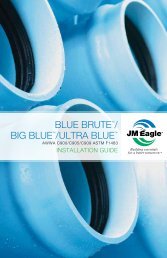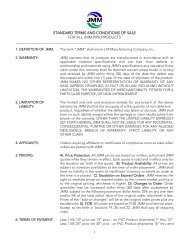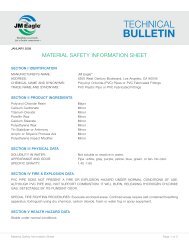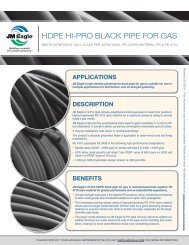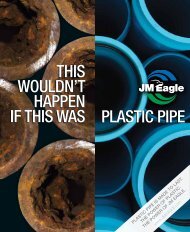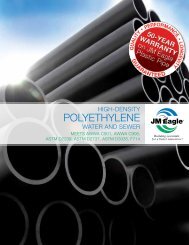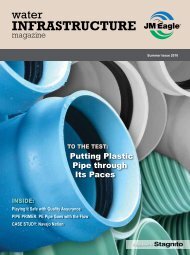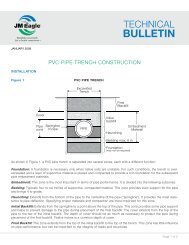EAGLE CORR PE⢠* - JM Eagle
EAGLE CORR PE⢠* - JM Eagle
EAGLE CORR PE⢠* - JM Eagle
- No tags were found...
You also want an ePaper? Increase the reach of your titles
YUMPU automatically turns print PDFs into web optimized ePapers that Google loves.
2.0 Trench Construction2.1 Working Ahead of the Pipe Laying CrewWhere soil and ground water conditions permit, long stretches of trench canbe opened ahead of pipe laying, so as to take full advantage of the easyhandling and speed of assembly of <strong>Eagle</strong> Corr PE sewer and storm drainpipe. However, as a general rule for most jobs, do not open the trench toofar ahead of pipe laying. Avoiding these long stretches of opened trench mayhelp with the economy of the project because:1. It may reduce or even eliminate pumping or sheeting.2. It minimizes the possibility of flooding the trench.3. It reduces caving caused by ground water.4. It helps avoid frozen trench bottom and backfill.5. It reduces hazards to traffic and workmen.On most jobs, it will be desirable to keep excavating, pipe laying and backfillingclose together.2.2 Curves in the TrenchThe trench may be curved to change direction or avoid obstructions withinthe limits of the curvature of the pipe as described below. Since the momentof inertia of <strong>Eagle</strong> Corr PE pipe is high, attempting to curve the pipe may bedifficult. If the pipe barrel cannot be curved, the joints may be deflected to amaximum of 1.5 degrees (or a radius of approximately 760 feet or a 6-inchoffset maximum). Offset and radius of curvature is based on a 19.8-footlength of pipe. To accomplish this, the pipe should be assembled in straightalignment and then, with the joint braced, the free end moved laterally usinga pry bar or other suitable means. Care should be taken not to exceed themaximum deflection allowed or damage the pipe with the machinery used.Abrupt changes in direction may be accomplished with fittings.14 <strong>EAGLE</strong> <strong>CORR</strong> PE INSTALLATION GUIDE




